Examples of Brands Excelling in Omnichannel Strategies
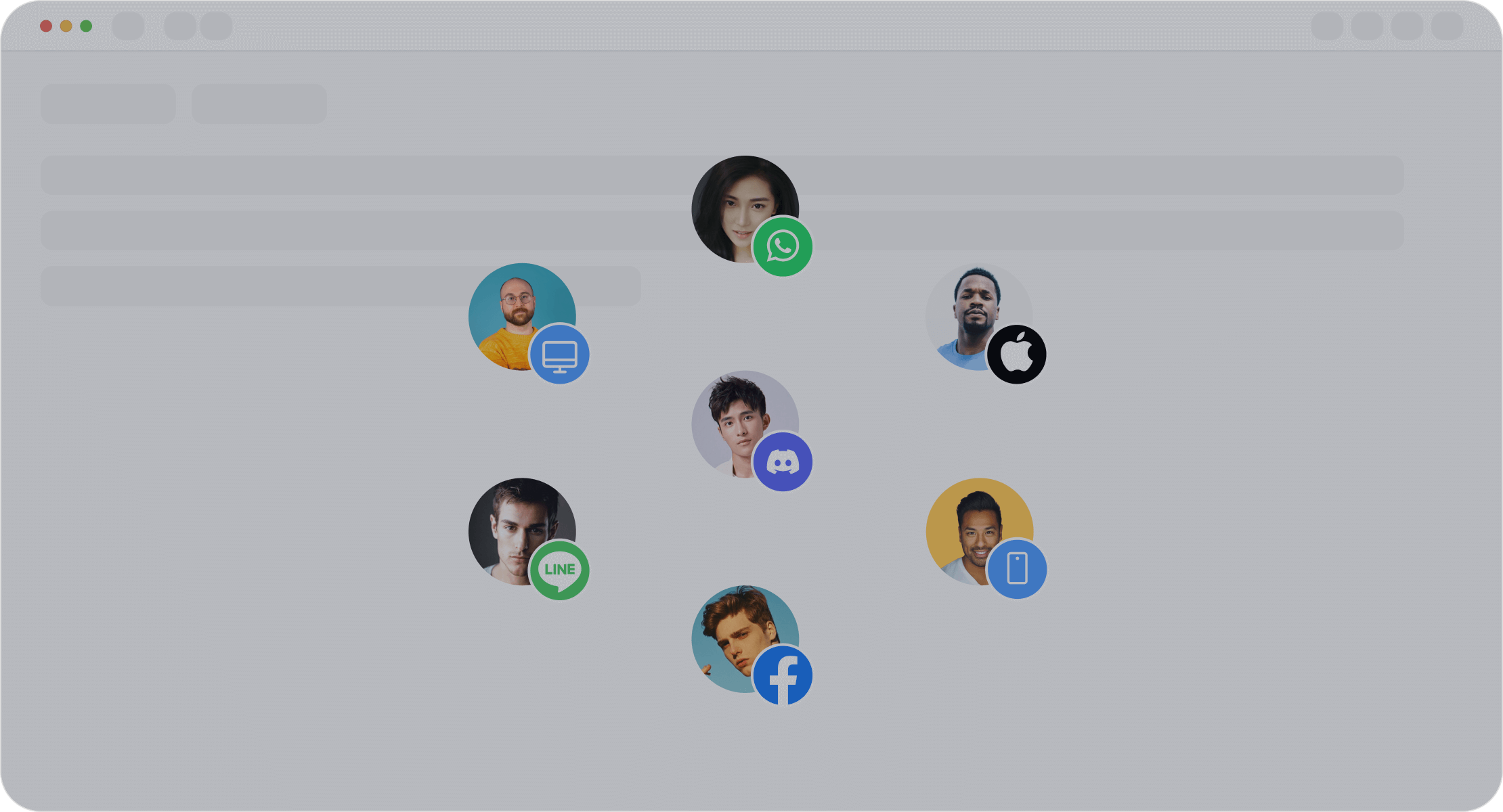
You interact with brands across multiple platforms every day. Whether shopping online, visiting a store, or messaging through social media, you expect seamless transitions. Omnichannel strategies make that possible. They enhance your experience by connecting all touchpoints. Companies adopting these strategies see remarkable results: customers shop 1.7 times more, and engagement rates soar by 250%. Businesses like Sobot simplify this process, helping brands deliver a unified omni-channel customer experience. With such strategies, you enjoy consistent service, whether online or offline, boosting satisfaction and loyalty.
What Defines a Successful Omni-Channel Customer Experience?
Seamless Integration Across Channels
A seamless shopping experience begins with integrating all communication channels into one cohesive system. You expect to switch between platforms like SMS, WhatsApp, and email without losing context. Successful brands achieve this by unifying their customer data and ensuring consistent service across touchpoints. For example, Microsoft uses social media, print, and AI-driven projects to create a unified marketing strategy. Emirates combines traditional media, event sponsorships, and owned media to maintain a consistent brand presence.
One case study highlights how a cloud-native omnichannel solution transformed customer communication. It integrated SMS, WhatsApp, email, and print, addressing challenges like managing large message volumes and multiple integration points. This approach ensures you experience smooth transitions between platforms, enhancing customer engagement and satisfaction.
Personalization and Customer-Centricity
Personalization drives loyalty and improves your overall customer experience. When brands tailor interactions to your preferences, you feel valued. Statistics show that 71% of consumers expect personalized interactions, while 76% get frustrated when they don’t happen. Moreover, 80% prefer brands that customize content, which strengthens loyalty.
| Statistic | Insight |
|---|---|
| 62% | Consumers change brands after a failed or non-personalized experience. |
| 71% | Buyers want personalized customer interactions. |
| 76% | Frustration arises when personalization is absent. |
| 80% | Customized content enhances loyalty. |
Personalization isn’t just about knowing your name; it’s about understanding your journey. Brands use customer journey mapping to anticipate your needs and optimize your buying experience. This approach ensures you receive relevant recommendations and timely support, creating a seamless shopping experience.
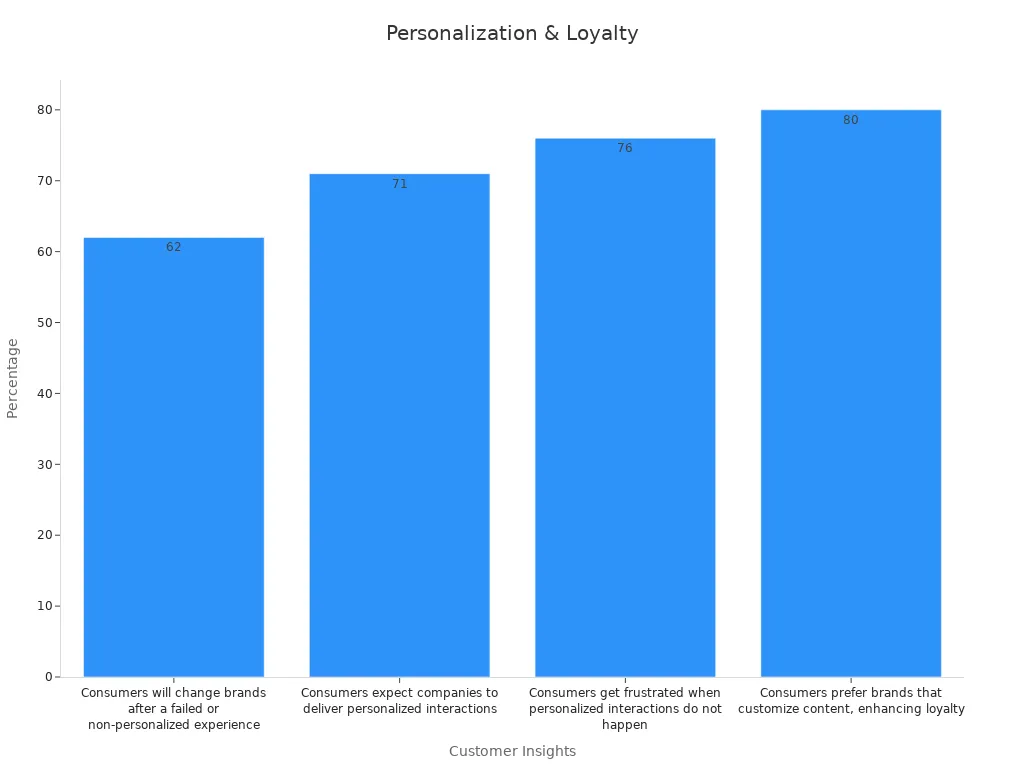
Data-Driven Decision-Making
Data fuels effective omnichannel strategies. Brands analyze customer interactions to make informed decisions that enhance your experience. For instance, Nike achieved a 110% revenue increase in one year by automating processes with SAP Emarsys. Multi-touch attribution helps brands understand how each interaction contributes to conversions, guiding marketing strategies.
| Evidence Type | Description |
|---|---|
| Revenue Increase | Nike achieved a +110% revenue increase from automation in the first year with SAP Emarsys. |
| Multi-touch Attribution | Credits partial conversions across user interactions, enhancing marketing insights. |
| Customer Lifetime Value (CLTV) | Identifies audience cohorts generating the most revenue, guiding strategic decisions. |
| Incremental Lift | Validates campaign impact using control groups, ensuring budgets align with outcomes. |
Real-time analytics also play a crucial role. They allow brands to track interactions, measure effectiveness, and adjust strategies to meet your expectations. This data-driven approach ensures you enjoy a seamless shopping experience tailored to your needs.
Consistent Branding and Messaging
Consistency in branding and messaging builds trust and strengthens your connection with a brand. When you see the same logo, tone, and visuals across platforms, you instantly recognize the brand. This familiarity makes you more likely to engage and stay loyal.
Brands that maintain consistent messaging ensure their audience understands their value. You can identify their products or services across platforms without confusion. Research shows that companies with consistent branding can increase revenue by up to 23%. Customers prefer engaging with brands they recognize and trust.
- Consistent messaging clarifies the brand’s value proposition for the audience.
- Unified visual elements improve brand recognition by up to 80%.
- A cohesive brand image enhances market perception and boosts revenue.
Consistency also strengthens brand recall. You remember brands that present themselves reliably across all touchpoints. This reliability fosters trust, making you feel confident in choosing their products or services. Studies confirm that consistent branding leads to deeper customer loyalty and higher revenue.
- A consistent brand fosters reliability and trust.
- It strengthens recall, making it easier for customers to remember the brand.
- Research indicates that consistent presentation can boost revenue by up to 23%.
When brands align their messaging across channels, they create a seamless experience for you. Whether you interact through social media, email, or in-store, the brand feels familiar and reliable. This unified approach enhances your perception of the brand’s worth and encourages long-term engagement.
Case Studies of Brands Excelling in Omni-Channel Customer Experience
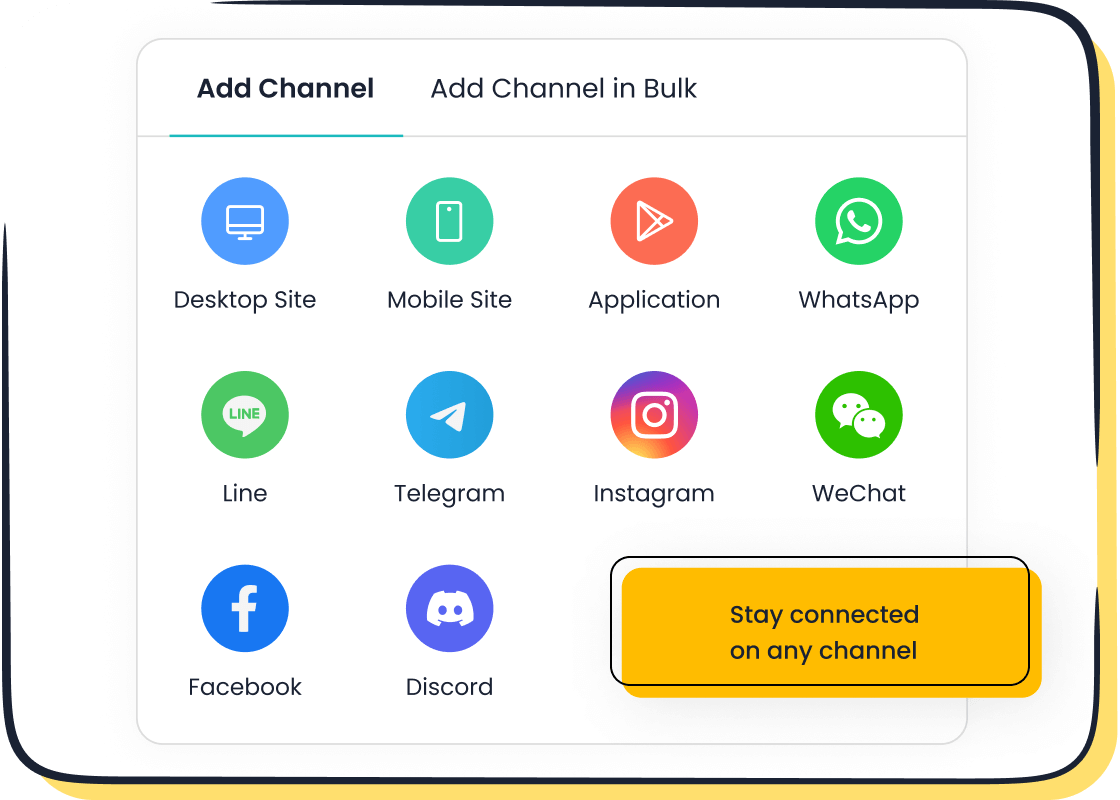
Amazon: Revolutionizing eCommerce with Omnichannel Integration
Amazon has set the gold standard for omnichannel strategies in eCommerce. By leveraging advanced personalization techniques, it creates a seamless shopping experience for its customers. Whether browsing online, using the mobile app, or visiting physical stores like Amazon Go, you encounter a unified and tailored journey. Amazon collects extensive customer data from interactions across channels. This data powers personalized product recommendations, targeted marketing campaigns, and even dynamic pricing models.
For example, when you shop on Amazon, the platform remembers your preferences, suggests complementary products, and provides real-time updates on your orders. This integration ensures you receive a cohesive experience, regardless of the channel you use. Amazon’s approach has transformed eCommerce, making it easier for customers to shop across online and offline channels.
Starbucks: Deepening Customer Loyalty Through Engagement
Starbucks excels at building customer loyalty through its omnichannel strategy. The Starbucks Rewards program connects online and offline channels, allowing you to earn points whether you order through the app, website, or in-store. The mobile app enhances customer engagement by offering personalized rewards, exclusive promotions, and convenient payment options.
Statistics highlight Starbucks’ success: app users visit stores weekly at a rate of 71%, and members are 5.6 times more likely to visit daily. The brand’s consistent messaging across platforms ensures you feel valued and engaged. Whether ordering ahead via the app or enjoying a coffee in-store, Starbucks creates a seamless experience that keeps you coming back.
| Metric Description | Value |
|---|---|
| Likelihood of daily visits for members | 5.6 times more likely |
| Weekly store visits by app users | 71% |
| Customer retention rate | 44% |
Sephora: Bridging Online and Offline Shopping Experiences
Sephora has mastered the art of blending online and offline channels to enhance your shopping experience. The brand integrates in-store and online data to create revamped customer profiles, ensuring personalized shopping experiences. For instance, when you browse products online, Sephora uses your preferences to recommend items during your next store visit.
Sephora also incorporates technology into its physical stores. Tools like hydration measurement devices help you find products tailored to your needs. Loyalty perks, such as free samples and exclusive discounts, combine online and offline benefits, boosting customer engagement. This strategy has led to impressive results, including a 35% increase in skincare sales after implementing digital tools.
“The walls separating ‘brick-and-click’ are coming down,” says George Musi, chief business officer of Night Market. “We're in the era of the pervasive store, where consumers can buy whatever they want, whenever, wherever, and however they want.”
| Evidence Type | Description |
|---|---|
| Revamped Customer Profiles | Integration of in-store and online data to enhance customer understanding. |
| Blended Benefits | Loyalty perks combining online and in-store experiences. |
| In-Store Tech Integration | Use of technology like hydration measurements to improve customer journeys. |
| Sales Growth | Skincare sales increased by 35% after implementing digital tools. |
Opay and Sobot: Transforming Financial Services with Omnichannel Solutions
Opay, a leading financial services platform, has redefined how you interact with financial products. By partnering with Sobot, Opay implemented an advanced omnichannel solution to streamline customer interactions. This collaboration ensures you experience seamless service across platforms like social media, email, and voice calls. Whether you’re transferring funds or seeking support, the system keeps your journey smooth and efficient.
Sobot’s omnichannel solution integrates all communication channels into a unified workspace. This allows Opay’s agents to manage inquiries without switching between platforms. For example, when you send an email, the system converts it into a ticket for faster resolution. If you prefer self-service, the intelligent IVR system guides you through common issues, saving time and effort. These features improve your shopping experience by making financial services more accessible and user-friendly.
The results speak for themselves. Opay achieved a 90% customer satisfaction rate, up from 60%. Operational costs dropped by 20%, and conversion rates increased by 17%. The WhatsApp Business integration also enhanced customer engagement, with 85% of messages being read. These improvements highlight how Sobot’s technology transforms the customer experience in financial services.
Tip: When choosing a financial service provider, look for one that prioritizes your convenience and satisfaction. Opay’s success with Sobot shows how technology can make your life easier.
Krispy Kreme: Enhancing Customer Satisfaction Through Multiple Channels
Krispy Kreme has mastered the art of connecting with you through multiple channels. Whether you’re ordering donuts online, visiting a store, or engaging on social media, the brand ensures a consistent and delightful experience. This multi-channel approach enhances your shopping experience and keeps you coming back for more.
Digital marketing plays a significant role in Krispy Kreme’s strategy. The company uses targeted campaigns to drive traffic to its website and stores. For instance, personalized promotions encourage you to try new flavors or take advantage of limited-time offers. These efforts have led to impressive results:
| Metric | Result |
|---|---|
| Increase in lead generation | 53% |
| Year-over-year growth in website clicks | 70% |
| Year-over-year growth in revenue | 19% attributed to digital marketing efforts |
In addition to digital efforts, Krispy Kreme integrates technology into its physical locations. Mobile apps allow you to place orders ahead of time, reducing wait times. Loyalty programs reward you for repeat purchases, creating a sense of value and appreciation. This combination of online and offline strategies ensures you enjoy a seamless customer experience.
Krispy Kreme’s success demonstrates the power of a well-executed omnichannel strategy. By meeting you where you are—whether online or in-store—the brand builds trust and loyalty. This approach not only enhances customer satisfaction but also drives long-term growth.
How Sobot's Live Chat Enhances Omni-Channel Customer Experience
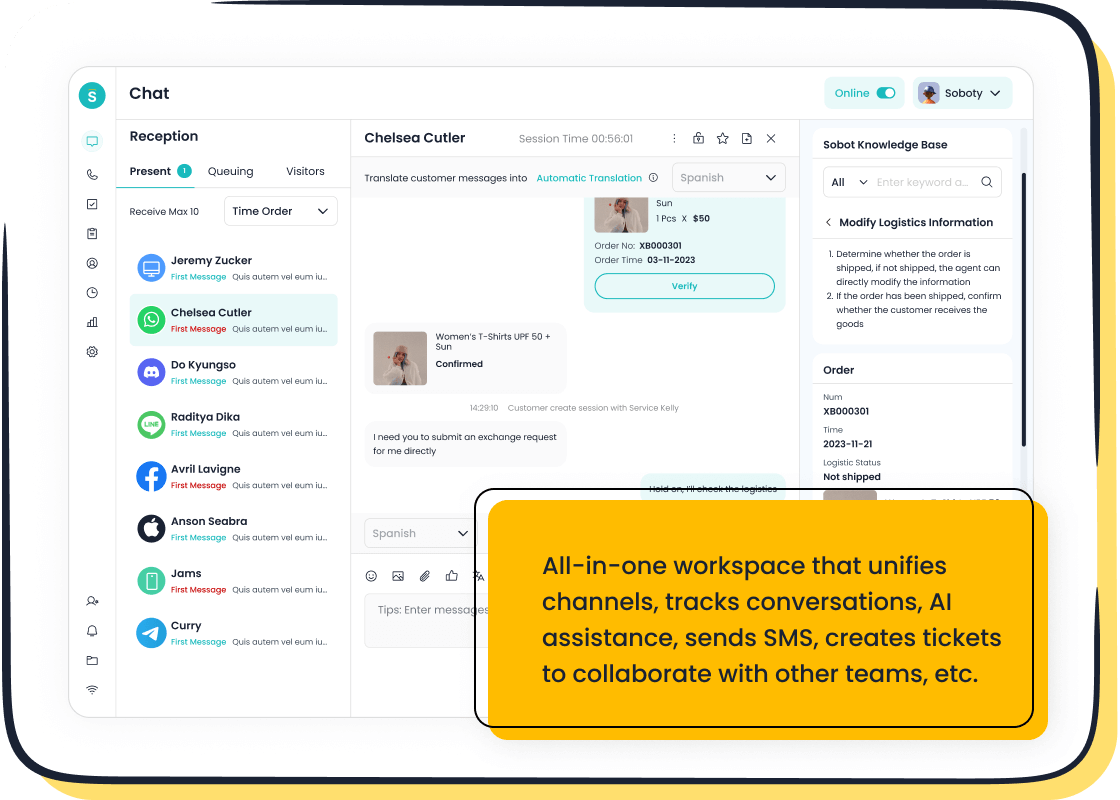
Unified Communication Across Channels
Sobot's Live Chat ensures you can interact with businesses seamlessly across multiple platforms. Whether you prefer WhatsApp, Facebook, or a website chat widget, the system unifies all communication channels into one workspace. This eliminates the need for agents to switch between platforms, allowing them to respond faster and more efficiently.
For example, after implementing Sobot's Live Chat, businesses have reported an 80% reduction in response time. Agent efficiency increased by 20%, enabling quicker resolutions and improved customer satisfaction. These improvements make your shopping experience smoother and more enjoyable.
| Metric | Value |
|---|---|
| Reduction in inbound discussion | 20% |
| Positive feedback rate | 96% |
| Correct answers by AI | 80% |
| Customer satisfaction (CSAT) | 97% |
| Problem resolution rate | 85% |
| Customer happiness rate | 99% |
| Sign-off rate increase | 35% |
| COD collection rate increase | 40% |
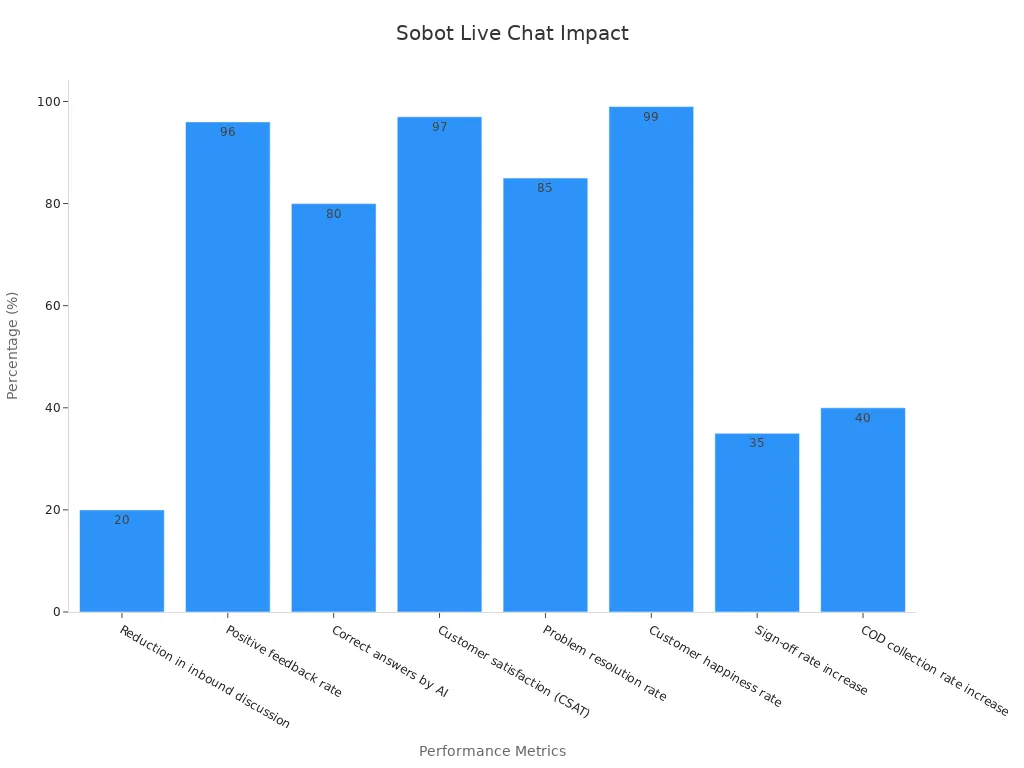
By integrating all channels into one system, Sobot's Live Chat ensures you never experience fragmented communication. This unified approach enhances the omni-channel customer experience, making interactions consistent and efficient.
AI-Powered Tools for Personalization
Personalization is key to creating memorable customer experiences, and Sobot's Live Chat excels in this area. The platform uses AI-powered tools to analyze your preferences and deliver tailored interactions. For instance, chatbots can provide instant responses to your queries, while recommendation engines suggest products based on your browsing history.
| AI Tool | Description |
|---|---|
| Chatbots | Automate communication, providing quick responses and support, improving efficiency and satisfaction. |
| Recommendation Engines | Analyze customer data to tailor product suggestions, enhancing shopping experiences and sales. |
| Sentiment Analysis Tools | Assess customer feedback to gauge satisfaction and identify improvement areas. |
| Behavioral Analytics | Monitor customer behavior to personalize experiences and boost engagement. |
| Automated Personal Assistants | Manage complex interactions, enhancing communication efficiency. |
Organizations that prioritize personalization see three times the revenue growth of their competitors. Dynamic customer experiences also lead to increased satisfaction and loyalty. For example, AI tools in Sobot's Live Chat can suggest products based on your demographics and past purchases, making your shopping experience more relevant and engaging.
Tip: Personalization not only improves your experience but also reduces customer acquisition costs by up to 50%.
Built-In Analytics for Data-Driven Insights
Sobot's Live Chat includes built-in analytics that help businesses make informed decisions. These analytics track customer interactions, measure agent performance, and identify areas for improvement. For example, if many customers inquire about order tracking, businesses can use this data to enhance real-time updates.
| Type of Data Analytics | Description | Source |
|---|---|---|
| Customer Transactions | Brands collect data on purchase history, browsing behavior, and engagement metrics. | McKinsey & Company, 2023 |
| Website & App Analytics | Insights on user journeys, page views, and conversion rates help improve digital platforms. | Google Marketing Platform, 2023 |
| Social Media Data | Analyzing sentiment, brand mentions, and customer interactions provides insights into preferences. | Sprout Social, 2023 |
| Demographic & Geographic Data | Understanding market trends and customer segmentation aids in targeted marketing strategies. | Statista, 2023 |
By leveraging these insights, businesses can optimize their omni-channel strategies. Sobot's analytics tools empower companies to address issues proactively, ensuring a seamless digital customer engagement experience. This data-driven approach enhances customer satisfaction and builds long-term loyalty.
Real-World Impact: Sobot's Success with Opay
Opay, a financial services platform, has transformed how you interact with payments, transfers, and loans. By adopting Sobot’s omnichannel solution, Opay streamlined its customer service and marketing operations. This partnership demonstrates how technology can improve your experience while boosting business efficiency.
Challenges Faced by Opay
Managing customer interactions across multiple channels posed significant challenges for Opay. You might have experienced delays or inconsistencies when reaching out for support. The company needed a unified system to handle inquiries efficiently and provide seamless service. Additionally, Opay wanted to enhance its marketing efforts to engage you better and retain your loyalty.
Sobot’s Solution
Sobot introduced its omnichannel platform to address these challenges. The solution unified communication channels like social media, email, and voice calls into one workspace. This integration allowed Opay’s agents to respond to your inquiries faster and with greater accuracy.
Key features of Sobot’s solution included:
- Email Ticketing System: Converts your emails into manageable tickets for quicker resolutions.
- Intelligent IVR System: Offers self-service options, saving you time and effort.
- WhatsApp Business Integration: Sends targeted promotional messages with high engagement rates.
These tools ensured you received consistent and personalized service, whether you contacted Opay via WhatsApp or email.
Results Achieved
The impact of Sobot’s solution on Opay was remarkable. You likely noticed faster response times and improved service quality. Here’s what the data shows:
| Metric | Before Sobot Solution | After Sobot Solution |
|---|---|---|
| Customer Satisfaction Rate | 60% | 90% |
| Operational Costs | High | Reduced by 20% |
| Conversion Rates | Moderate | Increased by 17% |
| WhatsApp Message Reading Rate | N/A | 85% |
The intelligent IVR system allowed 60% of customers to resolve issues independently. This reduced the workload on agents and improved your overall experience.
Note: Opay’s success highlights the importance of choosing a provider that prioritizes your convenience and satisfaction.
Why It Matters to You
When businesses like Opay adopt advanced solutions, your experience improves. You enjoy faster resolutions, personalized interactions, and seamless communication. Sobot’s technology ensures that every touchpoint feels connected, making your journey smoother and more enjoyable.
By leveraging Sobot’s omnichannel solution, Opay not only enhanced its operations but also demonstrated how innovation can transform customer service. This success story underscores the value of investing in tools that prioritize your needs.
Explore how Sobot’s solutions can elevate your experience: Sobot Omnichannel Solution
Lessons Learned from Leading Brands
The Role of Technology in Omnichannel Success
Technology plays a pivotal role in shaping your customer experience. Leading brands use advanced tools to create seamless interactions across channels. For example, Amazon leverages AI and machine learning to offer personalized recommendations, boosting customer satisfaction and loyalty. Sephora uses augmented reality to enhance engagement, helping you visualize products before purchasing. These innovations not only improve your experience but also drive business growth.
Statistics highlight the impact of technology on omnichannel strategies:
| Evidence Description | Statistic |
|---|---|
| Year-over-year customer retention rates | 91% greater for omnichannel vs. non-omnichannel |
| Lifetime value of omnichannel consumers | 30% higher than single/multichannel consumers |
| Annual revenue increase for strong omnichannel engagement | 9.5% vs. 3.4% for weaker engagement |
| Decrease in cost per contact | 7.5% for strong strategy vs. 0.2% for ineffective strategy |
| Customer expectation for consistent interactions | 90% of customers expect this across channels |
These numbers show how technology enhances customer retention and satisfaction. When brands invest in tools like AI-powered chatbots or advanced analytics, they create smoother and more personalized experiences for you.
Importance of Customer Data and Insights
Customer data is the backbone of personalized marketing. Brands use analytics to understand your preferences and anticipate your needs. Predictive analytics, for instance, forecasts future behaviors based on historical data, allowing companies to tailor their strategies. Real-time analytics provide instant feedback, helping marketers adjust campaigns to meet your expectations.
Coca-Cola’s ‘Share a Coke’ campaign is a great example. By analyzing regional name popularity, the brand customized its products, creating a personal connection with you. This approach demonstrates how data-driven insights can transform marketing efforts and boost engagement.
| Insight | Description |
|---|---|
| Advanced Analytics | Combines cultural insights with data to create hyper-personalized strategies that drive growth. |
| Predictive Analytics | Forecasts future events, enabling proactive customer engagement. |
| Real-Time Analytics | Offers instant insights for immediate campaign adjustments. |
When brands use data effectively, they improve your experience and strengthen customer retention. You feel valued when interactions align with your preferences, making you more likely to stay loyal.
Prioritizing Consistency Across Touchpoints
Consistency across channels builds trust and enhances your customer experience. You expect brands to deliver the same quality of service whether you interact online, in-store, or through social media. Leading companies achieve this by maintaining unified messaging and integrating customer data platforms.
To ensure consistency, brands follow key measures:
- Consistent brand messaging across all channels.
- Integrated customer data platforms for unified interactions.
- Regular cross-channel audits to maintain service quality.
Tracking performance metrics like Customer Satisfaction Score (CSAT) and Net Promoter Score (NPS) helps brands identify areas for improvement. Predictive analytics further streamline interactions by anticipating your needs. Attribution modeling assigns value to each touchpoint, ensuring every interaction contributes to your overall experience.
When brands prioritize consistency, they create a seamless journey for you. This reliability fosters trust and strengthens your connection with the brand, encouraging long-term loyalty.
Focusing on Customer-Centric Innovation
Customer-centric innovation places your needs at the heart of every decision. Brands that prioritize your preferences and expectations create experiences that feel tailored and meaningful. This approach not only enhances your satisfaction but also strengthens your loyalty. Companies that innovate with you in mind often lead the way in omnichannel success.
When businesses focus on customer-centric strategies, they use advanced tools like big data and AI to understand your behavior. For example, analyzing your purchase history helps brands predict what you might need next. This proactive approach ensures you receive relevant recommendations and timely support. As a result, your shopping journey becomes smoother and more enjoyable.
The impact of customer-centric innovation on omnichannel strategies is clear. Brands that adopt these methods see higher customer retention rates and satisfaction scores. For instance, Starbucks improved its Net Promoter Score (NPS) by 5% after enhancing its omnichannel services. Similarly, companies using big data have reported a 10% increase in customer satisfaction. These improvements show how innovation directly benefits you.
| Evidence Description | Statistic |
|---|---|
| Consumers using multiple channels during purchase journey | 73% |
| Year-over-year customer retention rate for strong omnichannel strategies | 91% higher |
| Increase in NPS for Starbucks after enhancing omnichannel service | 5% |
| Increase in customer satisfaction scores using big data | 10% |
| Average customer retention for strong omnichannel strategies | 89% vs 33% |
You expect seamless transitions between channels, and customer-centric innovation makes this possible. By focusing on your needs, brands create consistent and personalized experiences. This approach not only meets your expectations but also builds trust, ensuring you return time and time again.
The Future of Omni-Channel Customer Experience

Emerging Trends in Omnichannel Strategies
Omnichannel strategies are evolving rapidly to meet your expectations for seamless and personalized shopping experiences. Simply offering multiple channels is no longer enough. You now demand consistency and convenience across all touchpoints. Businesses are responding by integrating advanced technologies and reimagining how they engage with you.
Some key trends shaping the future include:
- Integration of AI for personalized experiences enhances satisfaction and loyalty.
- Retail stores are transforming into dynamic hubs that influence both in-store and online sales.
- Seamless shopping across multiple channels is becoming essential for meeting your expectations.
Innovative retailers are investing in immersive experiences to deepen engagement. For example, one-third of retail executives see enhancing the in-store experience as a critical growth opportunity. Interactions with store associates influence 21% of online purchases, showing how physical and digital channels work together.
Savvy retailers recognize that stores are not just sales outlets; they are powerful growth engines. This growth potential extends beyond immediate in-store sales, influencing sales in digital channels as well.
The Role of AI and Automation
AI and automation are revolutionizing how businesses deliver omnichannel customer experiences. These technologies allow brands to anticipate your needs, personalize interactions, and streamline operations. For instance, AI-powered chatbots handle up to 80% of routine inquiries, ensuring you receive quick and accurate responses. Predictive analytics improve service levels by 30%, helping businesses tailor their strategies to your preferences.
| Statistic | Description |
|---|---|
| Global contact center market growth | Projected to reach $496 billion by 2027, growing at a CAGR of 15.4% (Market Research Future, 2020) |
| AI-powered chatbots | Handle up to 80% of routine customer inquiries (Gartner, 2021) |
| Predictive analytics impact | Improves service levels by 30% (Deloitte, 2020) |
| Customer retention | Businesses with omnichannel strategies retain 89% of customers (Aberdeen, 2020) |
| Customer satisfaction increase | Automation leads to a 25% increase in satisfaction scores (Customer Contact Week Digital, 2021) |
| Cost reduction | Automated solutions reduce contact center costs by up to 30% (IDC, 2020) |
These advancements not only improve your experience but also reduce costs for businesses. As AI continues to evolve, you can expect even more personalized and efficient interactions across all channels.
How Sobot is Shaping the Future of Omnichannel Solutions
Sobot is leading the charge in transforming how businesses engage with you. By 2025, over 95% of customer interactions will involve AI, and Sobot is at the forefront of this shift. The company develops platforms that offer hyper-personalized experiences, ensuring you receive tailored support and recommendations.
Some of Sobot’s innovations include:
- Collaborating with OPay to enhance customer service efficiency and internal collaboration.
- Implementing a WhatsApp Business Account to improve marketing capabilities.
- Increasing customer satisfaction from 60% to 90%.
- Reducing overall costs by over 20%.
- Achieving a 17% increase in conversion rates.
These advancements demonstrate Sobot’s commitment to shaping the future of omnichannel solutions. By integrating AI and automation into its products, Sobot ensures you enjoy seamless and personalized interactions, whether you’re shopping online or seeking support.
Omnichannel strategies have become essential for delivering a seamless customer experience and driving business success. Businesses that integrate multiple communication channels see significant improvements in satisfaction, efficiency, and trust. For example, retail companies adopting omnichannel support report a 20% boost in customer satisfaction, while AI-powered tools reduce repeat calls by 50%.
| Statistic | Insight |
|---|---|
| 20% improvement in customer satisfaction | Retail businesses adopting omnichannel support experience enhanced service consistency. |
| 85% of customers report higher satisfaction | Access to multiple communication options significantly boosts customer satisfaction. |
| 50% decrease in repeat calls | AI-powered issue detection systems effectively resolve root causes. |
| 20% improvement in query resolution rates | AI-powered voicebots enhance efficiency in handling routine requests. |
| Ensured customer trust | Integration of AI with adherence to data privacy regulations maintains customer trust. |
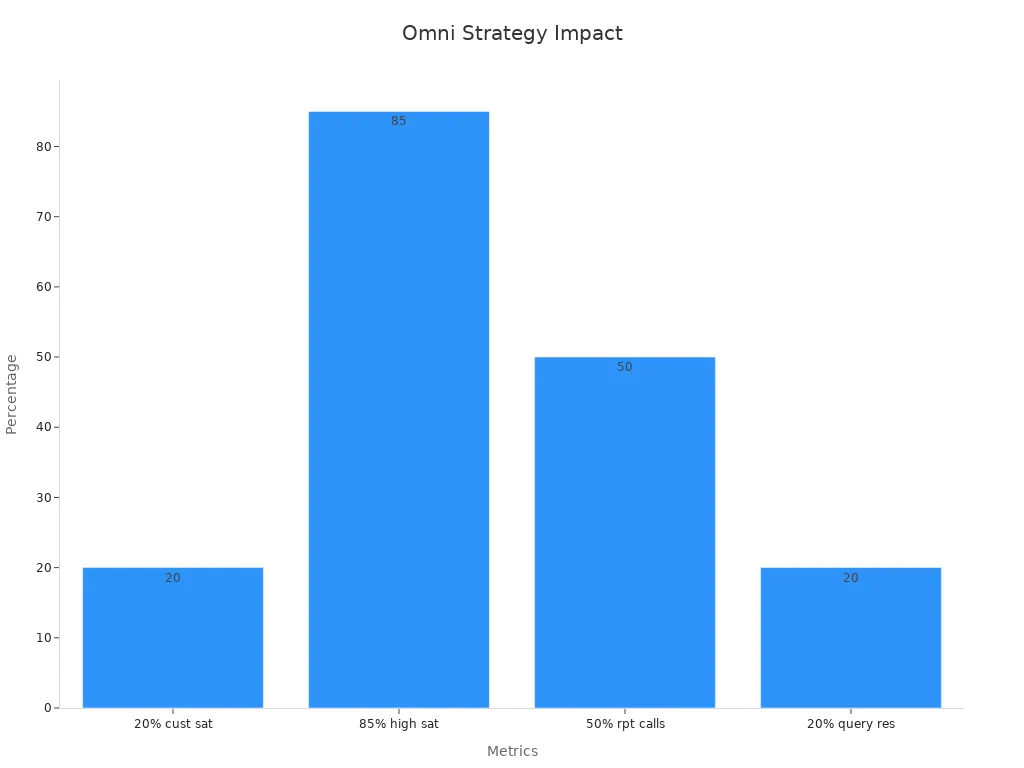
Sobot’s solutions, like Live Chat, empower businesses to implement these strategies effectively. By unifying communication channels and leveraging AI, Sobot helps you deliver consistent, personalized, and efficient service. Explore how Sobot can transform your approach to customer engagement and elevate your business outcomes.
FAQ
What is an omnichannel strategy?
An omnichannel strategy connects all customer touchpoints into one seamless experience. It ensures you receive consistent service whether you shop online, in-store, or through social media. This approach improves satisfaction and loyalty by unifying communication and personalizing interactions.
How does Sobot's Live Chat improve customer experience?
Sobot's Live Chat unifies all communication channels into one workspace. It uses AI tools to personalize interactions and built-in analytics to optimize service. This ensures faster responses, better engagement, and a seamless experience across platforms like WhatsApp, Facebook, and websites.
Why is personalization important in omnichannel strategies?
Personalization makes you feel valued by tailoring interactions to your preferences. It improves satisfaction, loyalty, and engagement. Brands use tools like AI and customer data to recommend products, anticipate needs, and provide relevant support, creating a more enjoyable shopping experience.
Can small businesses benefit from omnichannel solutions?
Yes, small businesses can use omnichannel solutions to improve efficiency and customer satisfaction. Tools like Sobot's Live Chat help unify communication, automate tasks, and provide personalized service. This approach enhances your experience and helps businesses grow by building trust and loyalty.
How does Sobot ensure data security in its solutions?
Sobot prioritizes data security by adhering to strict privacy regulations. Its platforms use encryption and secure protocols to protect your information. This ensures your data remains safe while you enjoy seamless and personalized interactions across all channels.
See Also
Essential Tips for Choosing Omnichannel Call Center Solutions
A Comprehensive Guide to Deploying Omnichannel Contact Centers
Comparing Leading Live Chat Solutions: Shopify and Rivals
